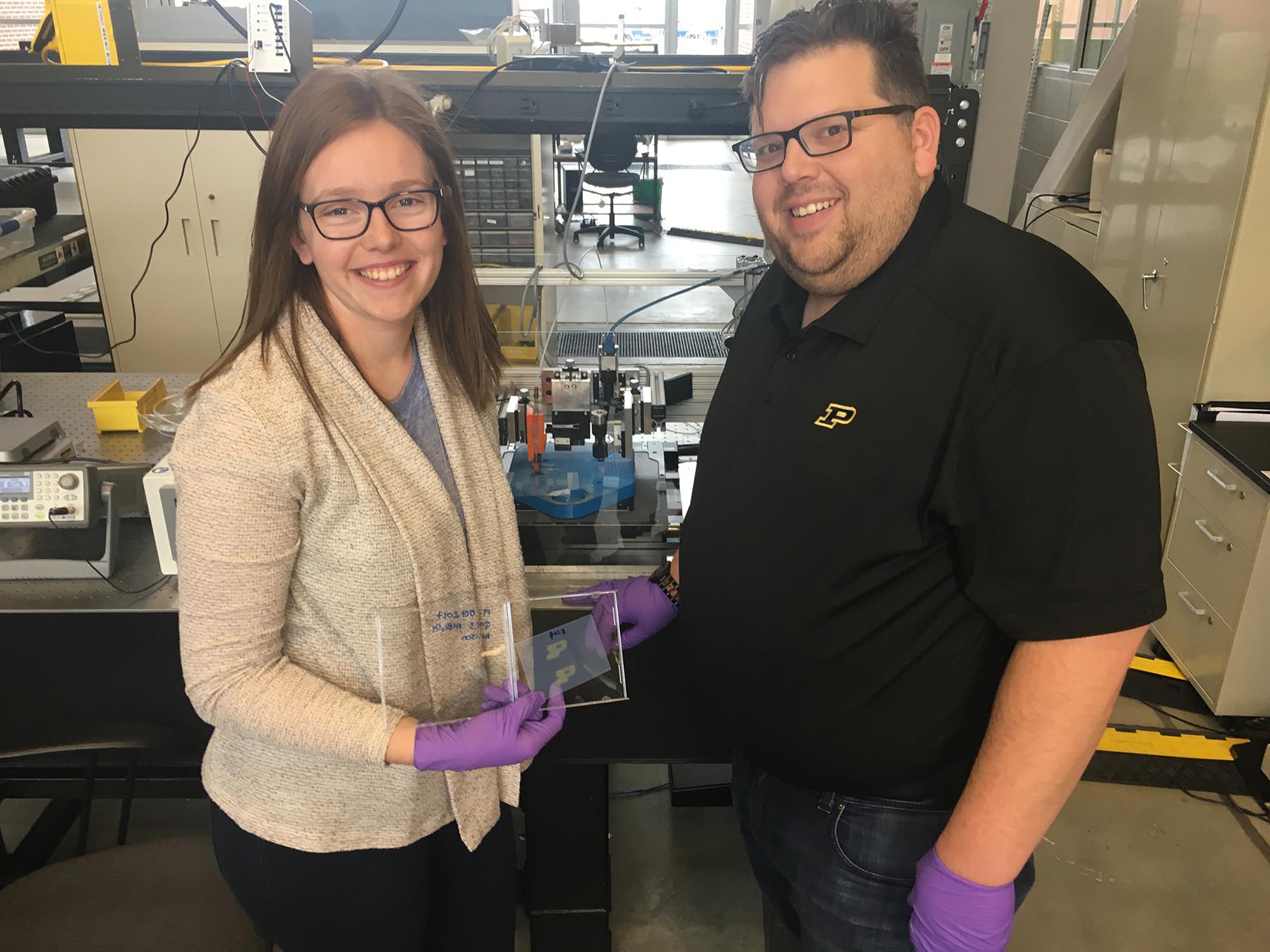Inkjet-printed thermite combines energetic materials and additive manufacturing
“Energetic materials is a fairly understood field, and so is additive manufacturing,” said Allison Murray, a Ph.D. candidate in Mechanical Engineering, who built the custom inkjet printer. “What’s unique about this project is the intersection of those two fields, and being able to safely deposit energetic materials with this level of precision.”
Many micromechanical systems incorporate energetic materials in their operation; for example, an automotive airbag deploys using a small amount of solid propellant. But as devices get smaller, the need for micro-level energetics becomes more critical.
 “Our solution is to combine two components as we’re printing them,” said Jeff Rhoads, professor of Mechanical Engineering, and principal investigator on the project. “We can have a fuel and an oxidizer in two separate suspensions, which are largely inert. Then with this custom inkjet printer, we can deposit the two in a specific overlapping pattern, combining them on a substrate to form nanothermite.”
“Our solution is to combine two components as we’re printing them,” said Jeff Rhoads, professor of Mechanical Engineering, and principal investigator on the project. “We can have a fuel and an oxidizer in two separate suspensions, which are largely inert. Then with this custom inkjet printer, we can deposit the two in a specific overlapping pattern, combining them on a substrate to form nanothermite.”
“We’re talking about picoliters of material,” said Murray. “It was a challenge to get the right droplet volume and the right pattern.” The other challenge: designing a machine that could deposit these droplets accurately. Murray’s machine holds the nozzle stationary, and moves a stage below it to form whatever shape is required. “The stage can move with a 0.1 micron precision, which is basically a thousandth the width of a human hair.”
The resulting nanothermite reacts just as quickly and powerfully as thermites applied in traditional ways. “It burns at 2,500 Kelvin [over 4,000 degrees Fahrenheit],” said Murray, “It generates a lot of thrust, a lot of heat, and makes a nice loud shockwave!”
The project, which has been published in the Journal of Applied Physics, has a team of 10 researchers and four faculty members from varying disciplines in Mechanical Engineering. Jeff Rhoads studies micro-electromechanical systems; George Chiu is an expert in inkjet printing; and Emre Gunduz and Steve Son work at Zucrow Labs, studying energetic materials like explosives, propellants, and pyrotechnics.
“It’s a defining feature of Purdue that professors from such different backgrounds can work together on a project like this,” said Rhoads. “We can combine all of our experiences to collaborate on technologies that weren’t previously realizable.”
This research was supported in part by the U.S. Department of Defense, Defense Threat Reduction Agency, through Grant No. HDTRA1-15-1-0010.
Writer: Jared Pike, 765-496-0374, jaredpike@purdue.edu
Source: Jeff Rhoads, 765-494-5630, jfrhoads@purdue.edu
Steve Son, 765-494-0539, sson@purdue.edu
ABSTRACT
Two-component additive manufacturing of nanothermite structures via reactive inkjet printing
Allison K. Murray, Tugba Isik, Volkan Ortalan, I. Emre Gunduz, Steven F. Son, George T.-C. Chiu, and Jeffrey F. Rhoads
Journal of Applied Physics 122, 184901 (2017); https://doi.org/10.1063/1.4999800
With an eye towards improving the safety of the deposition of energetic materials while broadening the scope of materials compatible with inkjet printing, this work demonstrates the use of combinatorial inkjet printing for the deposition of energetic materials. Two largely inert colloidal suspensions of nanoaluminum and nanocopper (II) oxide in dimethylformamide with polyvinylpyrrolidone were sequentially deposited on a substrate using piezoelectric inkjet printing. The materials were deposited in such a way that the aluminum and copper (II) oxide droplets were adjacent, and overlapping, to allow for in situ mixing of the components. The alternating deposition was repeated to create a sample with multiple layers of energetic materials. Energetic performance was subsequently tested on samples printed with 3, 5, and 7 layers of materials using a spark igniter. This ignition event was observed with a high speed camera and compared to representative samples printed with pre-mixed nanothermite. High speed thermal imaging supported a conclusion that the maximum reaction temperature of comparable samples printed with the dual nozzle technique was nominally 200 K less than the samples printed with a single nozzle. Scanning transmission electron microscopy images confirmed a claim that the material constituents were comparably mixed with the single and dual nozzle techniques. This work proves the feasibility of reactive inkjet printing as a means for depositing energetic materials from two largely inert suspensions. In doing so, it opens the doors for safer material handling and the development of a wide array of energetic materials that were previously deemed incompatible with inkjet printing.
